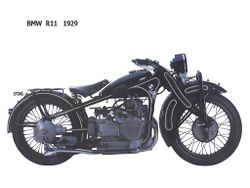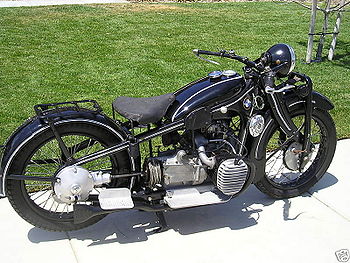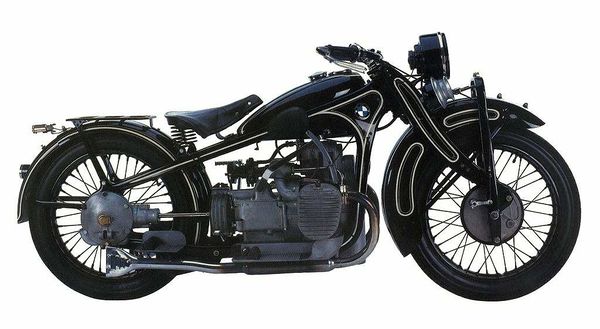Difference between revisions of "BMW R11"
m (no summary specified) |
|||
| Line 39: | Line 39: | ||
|fuel_capacity = 3.7 Gallon (14.00 Liters) | |fuel_capacity = 3.7 Gallon (14.00 Liters) | ||
|oil_capacity = | |oil_capacity = | ||
|fuel_consumption = 4.50 | |fuel_consumption = 4.50 liters/100 km (22.2 km/l or 52.27 mpg) | ||
|turning_radius = | |turning_radius = | ||
|related = [[BMW R16]] | |related = [[BMW R16]] | ||
Revision as of 02:33, 20 June 2019
 | |
| Manufacturer | BMW |
|---|---|
| Also called | R11 Series 1, R11 Series 2, R11 Series 3, R11 Series 5, R11 Series 4, R 11 |
| Production | 1929 - 1934 |
| Successor | BMW R12 |
| Class | Classic |
| Engine | two cylinder boxer, four-stroke |
| Bore / Stroke | 78.0mm x 78.0mm |
| Compression ratio | 5.5:1 |
| Top speed | 68 mph (110 km/h) |
| Horse Power | 17.57 HP (13.1 KW) @ 3400RPM |
| Ignition type | magneto |
| Battery | 5.5:1 |
| Transmission | Gear box: 3-speed Final Drive: shaft drive (cardan) |
| Suspension | Front: plate springe Rear: rigid |
| Brakes | Front: expanding brake (drum brake) Rear: 37mm cardan brake |
| Front Tire | 3.50-26.00 |
| Rear Tire | 3.50-26.00 |
| Wheelbase | 54.33 inches (1380 mm) |
| Dimensions | L 82.68 inches (2100 mm) W 35.04 inches (890 mm) H 37.01 inches (940 mm) |
| Weight | (dry), 162.0 kg (wet) |
| Fuel capacity | 3.7 Gallon (14.00 Liters) |
| Fuel consumption | 4.50 liters/100 km (22.2 km/l or 52.27 mpg) |
| Related | BMW R16 |
| Manuals | Service Manual |
| Tech Specs · Brochures · Reviews · Ads · Videos | |
The BMW R11 Series 4 was a two cylinder boxer, four-stroke Classic motorcycle produced by BMW between 1929 and 1934. It could reach a top speed of 68 mph (110 km/h). Claimed horsepower was 17.57 HP (13.1 KW) @ 3400 RPM.
History
Shortly after venturing into car manufacture for the first time by acquiring the Dixi works at Eisenach, BMW introduced a major innovation to its motorcycle range in 1929. The transversely mounted 'flat-twin' engine was already a BMW trademark but for the first time it was installed in a pressed-steel frame, the first model to incorporate this landmark of motorcycle design being the 740cc R11. BMW's relatively vibration-free engine was already a byword for smoothness and refinement, and this, coupled to a three-speed shaft-drive transmission, made the R11 sidevalve one of the finest touring motorcycles of its day. Progressively improved, the R11 was built in five series up to 1934. This R11 displays a total of only 4 kilometres on the odometer, which, presumably, is the distance covered since restoration.
Engine
The engine was a air cooled two cylinder boxer, four-stroke. A 78.0mm bore x 78.0mm stroke result in a displacement of just 745.0 cubic centimeters. Fuel was supplied via a sidevalves.
Drive
The bike has a 3-speed transmission. Power was moderated via the two plates-dry.
Chassis
It came with a 3.50-26.00 front tire and a 3.50-26.00 rear tire. Stopping was achieved via expanding brake (drum brake) in the front and a 37mm cardan brake in the rear. The front suspension was a plate springe while the rear was equipped with a rigid. The R11 Series 4 was fitted with a 3.7 Gallon (14.00 Liters) fuel tank. The wheelbase was 54.33 inches (1380 mm) long.
1929 - 1934 BMW R 11
The 1929 BMW R 11 sports an air-cooled, four-stroke, 745cc, twin cylinder powerplant paired to a three-speed manual transmission and can produce a claimed 20 horsepower at 4400 rpm. It comes with a plate spring front suspension, a rigid rear suspension with a sprung saddle, a dual exhaust system, a rear luggage rack, laced wheels, a round headlamp and a dry, single plate clutch.
In Media
| |||||||||||||||||

